2. 延边大学附属医院骨一科, 吉林 延吉 133000
2. Department of Orthopedics, Affiliated Hospital of Yanbian University, Yanji 133000, China
随着交通、建筑行业的迅速发展,高能量意外损伤呈增多趋势,其中踝关节骨折就是临床中常见的意外损伤,约占成人骨折的7.6%[1]。因踝关节特殊的解剖及皮肤血运特点,术后发生感染的概率较高,达4.4%~9.2%[2-4],可直接影响患者的预后,严重者造成残疾甚至截肢[5-6]。如何预防踝关节骨折术后切口感染的发生,是临床医生关注的热点[7]。研究[8-14]发现,高龄合并糖尿病、开放性骨折、ASA分级≥3级是踝关节术后发生感染的危险因素;术前常规使用抗菌药物[10-11, 13]是保护性因素,但也有学者持不同观点[15-16]。由于缺少术后切口感染的系统评价,本研究旨通过Meta分析踝关节术后切口感染的主要危险因素,为临床预防踝关节术后切口感染提供循证依据。
1 资料与方法 1.1 文献检索策略检索数据库中国知网(CNKI)、万方、VIP、PubMed、Embase、Web of Science、Cochrane Library数据库,采用主题词和自由词相结合的方式,检索时间为自建库以来至2021年6月。中文检索词为踝关节骨折、踝关节、脚踝、骨折;术后、围术期;切口感染、手术部位感染;危险因素、相关因素、影响因素;中文检索式为(踝关节骨折OR踝关节OR脚踝OR骨折)AND(术后OR围术期)AND(切口感染OR手术部位感染)AND(危险因素OR相关因素OR影响因素)。英文检索词为ankle fracture、ankle joint、fracture;perioperative period;surgical wound infection、surgical site infection、postoperative wound infections;risk factor、related factors、influence factor;英文检索式为(ankle fracture OR ankle joint OR fracture) and (perioperative period) and (surgical wound infection OR surgical site infection OR postoperative wound infections) and (risk factor OR related factors OR influence factor)。
1.2 文献纳入与排除标准纳入标准: (1)国内外公开发表的关于踝关节骨折术后切口感染的回顾性或前瞻性研究,文献数据准确、完整,可计算比值比(OR)、95%可信区间(CI);(2)明确为切口感染病例;(3)纳入NOS评分>5分的中高质量文献。排除标准:(1)重复出版,评论性综述论文、会议文献、病例报告;(2)数据不完整。
1.3 质量评价与数据提取应用Endnote X9软件由两名研究者独立进行文献筛选与质量评价,若有分歧与第三研究者进行协商。采用纽卡斯尔渥太华量表(Newcastle-Ottawa Scale,NOS)评分进行质量评价[17],≤5分为低质量研究,6分为中质量研究,≥7分为高质量研究。收集纳入文献的基本资料,包括第一作者、发表年份、研究地区、样本量、研究类型、随访时间和14个主要危险因素。
1.4 统计分析应用Rev Man 5.3和STATA 12.0软件进行文献的Meta分析。采用OR、均数差(MD)或标准化均数差(SMD)对二分类和连续性变量进行比较,区间估计用95%CI表示,P≤0.05为差异有统计学意义。通过I2检验界定研究间异质性,若I2<50%,P>0.1,表明研究有较高的同质性,采用固定效应模型;反之选择随机效应模型。通过变换效应模型进行敏感性分析,并检验结果的稳定性。采用Egger's检验分析发表偏倚性。
2 结果 2.1 文献检索结果根据检索策略,初步获得文献223篇,最终纳入12篇文献[8-14, 18-22]。文献筛选流程,见图 1。
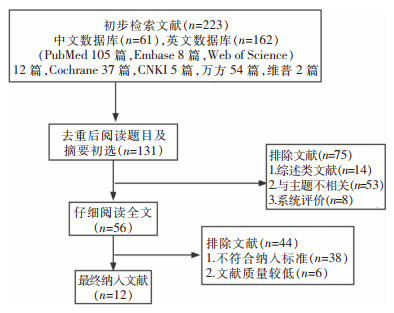 |
| 图 1 踝关节骨折术后切口感染危险因素Meta分析文献筛选流程图 Figure 1 Flow chart of literature screening for Meta-analysis on incisional infection after ankle fracture surgery |
纳入的12篇文献发表时间为2013—2021年,其中10篇为病例对照研究,2篇为队列研究,共纳入踝关节骨折患者10 037例,其中切口感染患者560例,提取14个危险因素。见表 1。
| 表 1 踝关节骨折患者切口感染危险因素Meta分析纳入文献基本特征 Table 1 Basic characteristics of included literatures for Meta-analysis on incisional infection in patients after ankle fracture surgery |
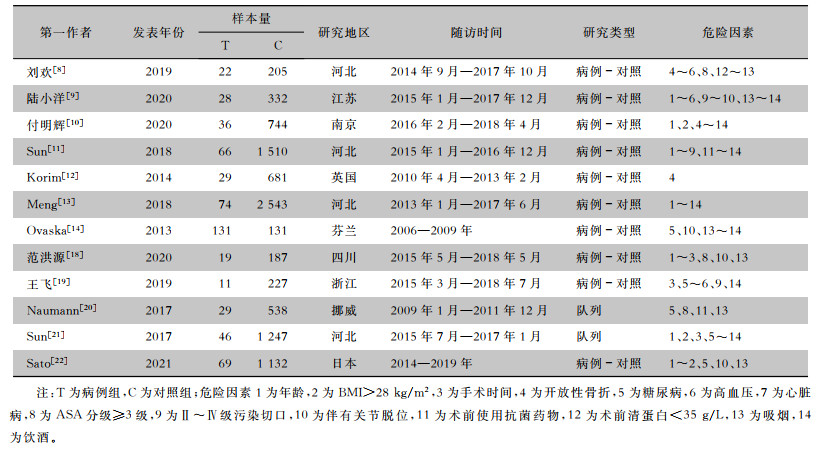
|
纳入的12篇文献中,NOS评分6、7分各6篇,文献总体质量较高。见表 2。
| 表 2 踝关节骨折患者切口感染危险因素Meta分析纳入文献质量评价结果 Table 2 Quality evaluation results of included literatures for Meta-analysis on incisional infection in patients after ankle fracture surgery |

|
Meta分析结果显示,年龄、BMI、手术时间、开放性骨折、糖尿病、心脏病、ASA分级≥3级、Ⅱ~Ⅳ级污染切口、骨折脱位、术前清蛋白<35 g/L、吸烟、饮酒是踝关节骨折术后切口感染的危险因素,差异均有统计学意义(均P<0.05);高血压、术前使用抗菌药物比较,差异均无统计学意义(P>0.05)。见表 3。各危险因素的森林图,见图 2。
| 表 3 踝关节骨折患者切口感染危险因素的Meta分析结果 Table 3 Meta-analysis on risk factors for incisional infection in patients after ankle fracture surgery |
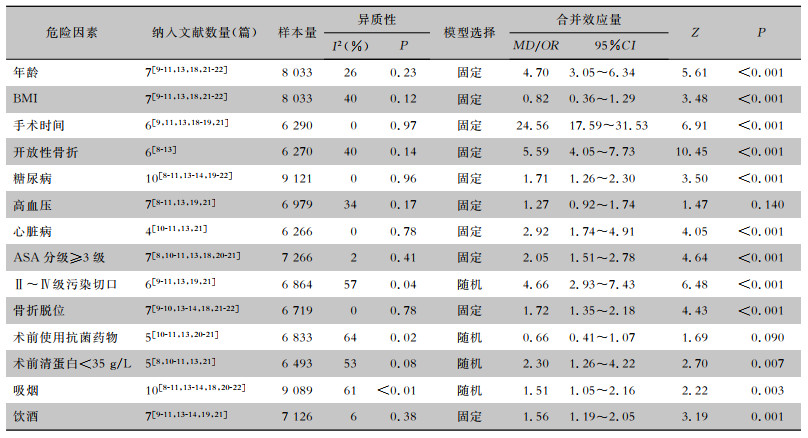
|
 |
| 图 2 踝关节骨折患者术后切口感染危险影响Meta分析结果森林图 Figure 2 Forest plot of Meta-analysis on risk factors for post-operative incisional infection in patients after ankle fracture surgery |
采用固定效应模型和随机效应模型比较合并结果的稳定性,结果显示,危险因素效应量变化均不明显,结果稳定,可信度高。见表 4。
| 表 4 各危险因素随机与固定效应模型合并结果比较 Table 4 Comparison of combined results of risk factors between random and fixed effect models |
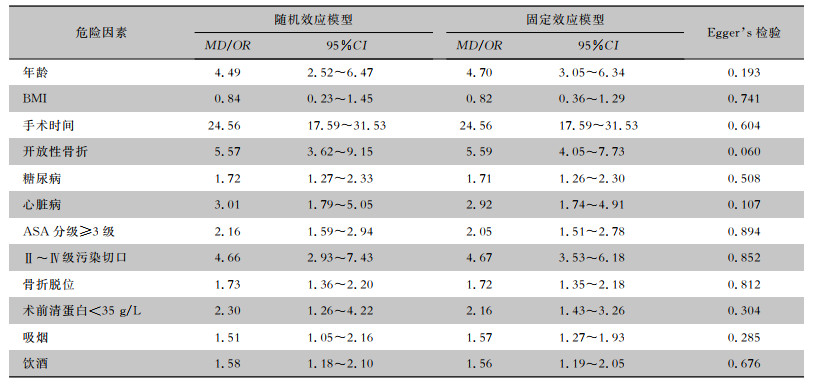
|
依据Cochrane手册要求,当纳入文献数≥10个应作漏斗图进行偏倚性分析[23]。本研究对吸烟和糖尿病2项因素作漏斗图分析,并结合Egger's进行发表偏倚检验,结果显示,吸烟、糖尿病P值分别为0.285、0.508,基于当前检验水准,未检测到发表偏倚。见图 3。
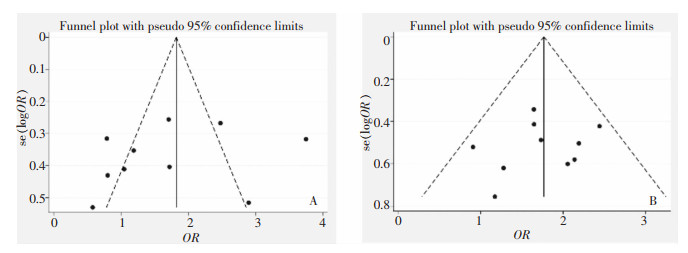 |
| 注:A为吸烟;B为糖尿病。 图 3 危险因素漏斗图分析结果 Figure 3 Funnel plot analysis results of risk factors |
研究结果显示,年龄是踝关节骨折患者术后切口感染的危险因素。人体机能随着年龄的增长而衰退,机体免疫力和组织修复能力降低,身体抵抗力也下降。合并基础疾病也是术后切口感染的易感原因之一,糖尿病患者往往出现机体免疫力下降、体质差等情况,血糖升高为细菌提供良好的生存繁殖环境,同时糖尿病会使机体血管发生病变,尤其四肢远端更加容易出现切口感染。研究证实,伴有糖尿病的患者术后感染风险增加10%~50%[24-26],因此在围手术期需将血糖控制在理想范围之内,以降低切口感染的危险。
本研究结果显示,手术时间延长是切口感染的高危险因素(MD=24.56)。杨彪等[27]研究表明,手术时间≥3 h术后感染率为13.11%。手术时间长,说明手术难度大,术中需要术区剥离,对软组织损伤程度加大,长时间切口的暴露,增加感染的风险。针对此危险因素,要充分做好术前准备,术中严格执行无菌操作,减少出血量,尽量缩短手术时间,必要时进行分期手术,降低切口感染的发生。
开放性骨折骨折处皮肤或黏膜破裂,骨折端与外界相通,细菌易进入局部组织,存在潜在风险。当机体体质较弱或局部血运不良时,潜伏的细菌将快速繁殖,导致切口感染。因此,开放性骨折要尽早进行清创(伤后6~8 h内)[28],伤情较严重者应在手术室内进行清创,同时要去除失去血运的软组织,清除异物[29]。
尽管大多数危险因素无法避免,但也有危险因素,如吸烟、饮酒和BMI,可以通过患者行为改变而改善。纳入的研究大多没有描述吸烟量,可能是导致异质性较大的原因。过度饮酒会降低免疫能力,术后易出现并发症。而Shabanzadeh等[30]研究发现,当调整年龄和吸烟等因素时,饮酒对术后切口感染无明显影响。因此,今后需要大样本和多变量分析以提高结果的可靠性。本结果显示,BMI与切口感染呈正相关。考虑是BMI指数增加,身体过度肥胖,受伤处皮下脂肪增加,在手术过程中易出现局部供血不足,组织缺血缺氧,致使脂肪液化等情况发生,从而形成窦道[31]。针对肥胖者,术后要密切观察切口变化,及时处理引流,预防切口感染的发生。
人们普遍认为预防性使用抗菌药物能有效降低术后切口感染的发生率,但对于接受清洁切开复位内固定术(ORIF)且切口感染风险较低的患者,抗菌药物使用效果并不明显,相关研究[15-16, 32-33]也未证实术前预防性使用抗菌药物对于降低术后切口感染有效。由于对切口感染的过度恐惧,医生在术前常规使用抗菌药物预防切口感染,以至于抗菌药物不合理使用(如伤口裂开但无感染使用抗菌药物),导致过度治疗,需要引起临床医生的高度重视。国内预防手术感染的指南提出,在进行开放性骨折、骨科手术前携带金黄色葡萄球菌者,应术前120 min内预防性使用抗菌药物,反对以预防切口感染为目的或其他原因预防性的使用抗菌药物[34]。针对切口感染的危险因素,术中要充分冲洗,重视无菌区域的细致维护,以达到预防感染的目的;针对术后感染性伤口应依据菌群选择敏感的抗菌药物。
本研究存在以下局限性:(1)纳入的文献样本量差异较大,可能导致某些因素进行合并分析时出现较大异质性;(2)由于纳入文献数量有限,导致部分因素无法进行合并分析;(3)仅收集到公开发表的文献,未获得未发表文献,可能会存在一定的发表偏倚。
本研究在文献筛选和质量评价方面较为严格,NOS评分均>5分,导致纳入的文献相对较少,通过Egger's检验纳入的12篇文献没有发表偏倚。本研究从患者自身因素、围手术期及生活习惯等方面对踝关节骨折术后切口感染进行了比较全面的评价。研究发现,年龄、手术时间、开放性骨折、心脏病、Ⅱ~Ⅳ级污染切口等与踝关节骨折术后切口感染的发生关系密切,对于闭合性骨折患者术前不建议预防性使用抗菌药物。临床中涉及切口感染危险因素较多,医务人员可参考研究结果,对高危人群采取针对性的干预措施,以降低切口感染发生率。
利益冲突:所有作者均声明不存在利益冲突。
| [1] |
Shank JR, Benirschke SK, Swords MP. Treatment of periphe- ral talus fractures[J]. Foot Ankle Clin, 2017, 22(1): 181-192. DOI:10.1016/j.fcl.2016.09.012 |
| [2] |
Huntley SR, Lee S, Kalra R, et al. Associations between season and surgical site infections in orthopaedic foot and ankle surgery[J]. Foot (Edinb), 2018, 37: 61-64. DOI:10.1016/j.foot.2018.04.008 |
| [3] |
Rascoe AS, Kavanagh MD, Audet MA, et al. Factors associa- ting with surgical site infection following operative management of malleolar fractures at an urban level 1 trauma center[J]. OTA Int, 2020, 3(2): e077. DOI:10.1097/OI9.0000000000000077 |
| [4] |
陶一明, 王志明. 《外科手术部位感染的预防指南(2017)》更新解读[J]. 中国普通外科杂志, 2017, 26(7): 821-824. Tao YM, Wang ZM. Interpretation of update in guideline for the prevention of surgical site infection, 2017[J]. Chinese Journal of General Surgery, 2017, 26(7): 821-824. |
| [5] |
贺毅, 郑聪, 何敏辉, 等. 螺钉内固定与保守治疗后踝骨折: 踝关节功能和足底压力的差异[J]. 中国组织工程研究, 2021, 25(27): 4379-4385. He Y, Zheng C, He MH, et al. Screw internal fixation and conservative treatment of posterior ankle fractures: differences in ankle joint function and plantar pressure[J]. Chinese Journal of Tissue Engineering Research, 2021, 25(27): 4379-4385. DOI:10.12307/2021.200 |
| [6] |
Schweizer ML, Cullen JJ, Perencevich EN, et al. Costs associated with surgical site infections in veterans affairs hospitals[J]. JAMA Surg, 2014, 149(6): 575-581. DOI:10.1001/jamasurg.2013.4663 |
| [7] |
de Lissovoy G, Fraeman K, Hutchins V, et al. Surgical site infection: incidence and impact on hospital utilization and treatment costs[J]. Am J Infect Control, 2009, 37(5): 387-397. DOI:10.1016/j.ajic.2008.12.010 |
| [8] |
刘欢, 刘阳, 朱叶珊, 等. 踝关节骨折切开复位内固定术后切口感染的发生率及危险因素分析[J]. 世界最新医学信息文摘: 连续型电子期刊, 2019, 19(12): 31-32, 36. Liu H, Liu Y, Zhu YS, et al. Incidence and risk factors of incision infection after open reduction and internal fixation for ankle fracture[J]. World Latest Medicine Information, 2019, 19(12): 31-32, 36. |
| [9] |
陆小洋, 席武. 踝关节骨折切开复位内固定术后手术部位感染的发生率及危险因素分析[J]. 创伤外科杂志, 2020, 22(11): 851-855. Lu XY, Xi W. Incidence and risk factors of surgical site infection after open reduction and internal fixation of ankle fracture[J]. Journal of Traumatic Surgery, 2020, 22(11): 851-855. DOI:10.3969/j.issn.1009-4237.2020.11.013 |
| [10] |
付明辉, 吴富华, 李群, 等. 踝关节骨折术后感染率及危险因素分析[J]. 创伤外科杂志, 2020, 22(8): 570-573, 587. Fu MH, Wu FH, Li Q, et al. Surgical site infection after open reduction and internal fixation of ankle fracture, a retrospective study regarding incidence and risk factors[J]. Journal of Traumatic Surgery, 2020, 22(8): 570-573, 587. |
| [11] |
Sun YN, Wang HJ, Tang YC, et al. Incidence and risk factors for surgical site infection after open reduction and internal fixation of ankle fracture: a retrospective multicenter study[J]. Medicine (Baltimore), 2018, 97(7): e9901. DOI:10.1097/MD.0000000000009901 |
| [12] |
Korim MT, Payne R, Bhatia M. A case-control study of surgical site infection following operative fixation of fractures of the ankle in a large U.K. trauma unit[J]. Bone Joint J, 2014, 96-B(5): 636-640. DOI:10.1302/0301-620X.96B5.33143 |
| [13] |
Meng JH, Sun T, Zhang FQ, et al. Deep surgical site infection after ankle fractures treated by open reduction and internal fixation in adults: a retrospective case-control study[J]. Int Wound J, 2018, 15(6): 971-977. DOI:10.1111/iwj.12957 |
| [14] |
Ovaska MT, Mäkinen TJ, Madanat R, et al. Risk factors for deep surgical site infection following operative treatment of ankle fractures[J]. J Bone Joint Surg Am, 2013, 95(4): 348-353. DOI:10.2106/JBJS.K.01672 |
| [15] |
Backes M, Dingemans SA, Dijkgraaf MGW, et al. Effect of antibiotic prophylaxis on surgical site infections following removal of orthopedic implants used for treatment of foot, ankle, and lower leg fractures: a randomized clinical trial[J]. JAMA, 2017, 318(24): 2438-2445. DOI:10.1001/jama.2017.19343 |
| [16] |
Lachman JR, Elkrief JI, Pipitone PS, et al. Comparison of surgical site infections in ankle fracture surgery with or without the use of postoperative antibiotics[J]. Foot Ankle Int, 2018, 39(11): 1278-1282. DOI:10.1177/1071100718788069 |
| [17] |
Stang A. Critical evaluation of the newcastle-ottawa scale for the assessment of the quality of nonrandomized studies in Meta-analyses[J]. Eur J Epidemiol, 2010, 25(9): 603-605. DOI:10.1007/s10654-010-9491-z |
| [18] |
范洪源, 杨海皓, 黄俊程. 闭合性踝关节骨折术后发生手术部位感染的危险因素分析[J]. 中华骨与关节外科杂志, 2020, 13(2): 154-158. Fan HY, Yang HH, Huang JC. Risk factors for surgical site infection following surgery of closed ankle fractures[J]. Chinese Journal of Bone and Joint Surgery, 2020, 13(2): 154-158. DOI:10.3969/j.issn.2095-9958.2020.02.12 |
| [19] |
王飞, 周崇斌, 梁伟, 等. 切开复位内固定治疗踝关节骨折术后感染的相关因素分析及检测[J]. 中国中医骨伤科杂志, 2019, 27(7): 41-44. Wang F, Zhou CB, Liang W, et al. Relevant factors of infection after open reduction and internal fixation for ankle fracture[J]. Chinese Journal of Traditional Medical Traumatology & Orthopedics, 2019, 27(7): 41-44. |
| [20] |
Naumann MG, Sigurdsen U, Utvåg SE, et al. Functional outcomes following surgical-site infections after operative fixation of closed ankle fractures[J]. Foot Ankle Surg, 2017, 23(4): 311-316. DOI:10.1016/j.fas.2016.10.002 |
| [21] |
Sun R, Li MQ, Wang XF, et al. Surgical site infection follo-wing open reduction and internal fixation of a closed ankle fractures: a retrospective multicenter cohort study[J]. Int J Surg, 2017, 48: 86-91. DOI:10.1016/j.ijsu.2017.10.002 |
| [22] |
Sato T, Takegami Y, Sugino T, et al. Smoking and trimalleolar fractures are risk factors for infection after open reduction and internal fixation of closed ankle fractures: a multicenter retrospective study of 1, 201 fractures[J]. Injury, 2021, 52(7): 1959-1963. DOI:10.1016/j.injury.2021.04.017 |
| [23] |
Cumpston M, Li TJ, Page MJ, et al. Updated guidance for trusted systematic reviews: a new edition of the cochrane handbook for systematic reviews of interventions[J]. Cochrane Database Syst Rev, 2019, 10: ED000142. |
| [24] |
Dellenbaugh SG, Dipreta JA, Uhl RL. Treatment of ankle fractures in patients with diabetes[J]. Orthopedics, 2011, 34(5): 385. DOI:10.3969/j.issn.1008-5572.2011.05.001 |
| [25] |
Flynn JM, Rodriguez-del Rio F, Pizá PA. Closed ankle fractures in the diabetic patient[J]. Foot Ankle Int, 2000, 21(4): 311-319. DOI:10.1177/107110070002100407 |
| [26] |
覃作恒, 李立军, 倪东馗. 脊柱术后发生手术部位感染独立危险因素的Meta分析[J]. 中国组织工程研究, 2020, 24(24): 3918-3924. Qin ZH, Li LJ, Ni DK. Meta-analysis of independent risk factors for surgical site infection after spinal surgery[J]. Chinese Journal of Tissue Engineering Research, 2020, 24(24): 3918-3924. DOI:10.3969/j.issn.2095-4344.2754 |
| [27] |
杨彪, 王瑶, 赵晓光, 等. 踝关节和Pilon骨折手术部位感染危险因素[J]. 中国感染控制杂志, 2015, 14(12): 818-820. Yang B, Wang Y, Zhao XG, et al. Risk factors for surgical site infection following ankle joint and Pilon fracture surgery[J]. Chinese Journal of Infection Control, 2015, 14(12): 818-820. DOI:10.3969/j.issn.1671-9638.2015.12.007 |
| [28] |
Gao X, Yin HL, Sun JX. Preoperative irrigation and vacuum sealing drainage with antibiotic-containing drainage fluid of foot and ankle wounds improves outcome of reconstructive skin flap surgery[J]. J Orthop Surg Res, 2019, 14(1): 374. DOI:10.1186/s13018-019-1418-0 |
| [29] |
胡珊珊, 唐文怡, 曹进. 负压密闭引流治疗开放性骨折患者的护理[J]. 解放军护理杂志, 2008, 25(23): 44-45. Hu SS, Tang WY, Cao J. Nursing care of patients with open fracture treated by negative pressure closed drainage[J]. Nursing Journal of Chinese People's Liberation Army, 2008, 25(23): 44-45. DOI:10.3969/j.issn.1008-9993.2008.23.018 |
| [30] |
Shabanzadeh DM, Sørensen LT. Alcohol drinking does not affect postoperative surgical site infection or anastomotic lea- kage: a systematic review and Meta-analysis[J]. J Gastrointest Surg, 2014, 18(2): 414-425. DOI:10.1007/s11605-013-2275-5 |
| [31] |
Yuan K, Chen HL. Obesity and surgical site infections risk in orthopedics: a Meta-analysis[J]. Int J Surg, 2013, 11(5): 383-388. DOI:10.1016/j.ijsu.2013.02.018 |
| [32] |
Bandalović A, Zindović A, Boschi V, et al. A retrospective study of antibiotic prophylaxis value in surgical treatment of lower limb fracture[J]. Injury, 2015, 46(Suppl 6): S67-S72. |
| [33] |
Crist BD, Oladeji LO, Della Rocca GJ, et al. Evaluating the duration of prophylactic post-operative antibiotic agents after open reduction internal fixation for closed fractures[J]. Surg Infect (Larchmt), 2018, 19(5): 535-540. DOI:10.1089/sur.2018.018 |
| [34] |
李国宏. "手术部位感染的预防"相关指南要点解读[J]. 上海护理, 2019, 19(8): 1-4. Li GH. Interpretation of key points of relevant guidelines of "prevention of surgical site infection"[J]. Shanghai Nursing, 2019, 19(8): 1-4. DOI:10.3969/j.issn.1009-8399.2019.08.001 |



